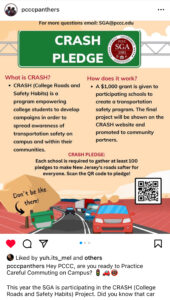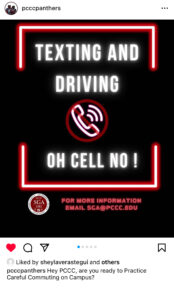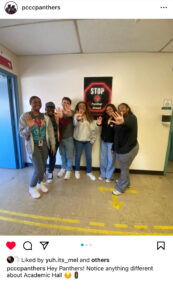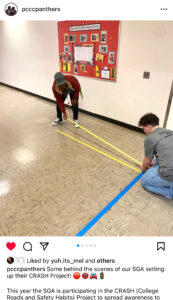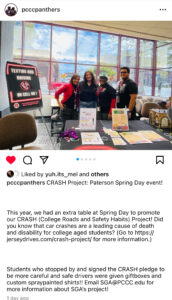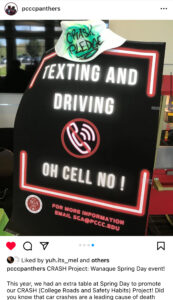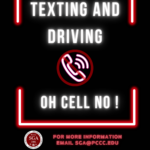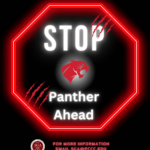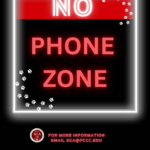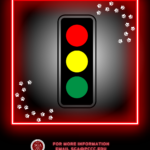Passaic County Community College
PCCC Practices Careful Commuting on Campus
How many students heard the message of your project? 1200
Project Description:
Description of project objective and its implementation.
Our project seeks to revamp a heavy-trafficked hallway on our main Paterson campus into a dynamic city road, not just for transportation but for education. This initiative aims to capture the attention of our students by turning their daily commute from class to class into an engaging experience. By creating a visually stimulating environment, we strived to spark curiosity and prompt discussions about road safety and responsible driving habits. Each section of the hallway displays informative posters, like “STOP Panther Ahead,” and “Texting and Driving, Oh Cell No!” to remind students to watch out for pedestrians and to put down their phone while driving. For our poster designs, we chose a black background and neon glowing fonts to remind students of New Jersey’s famous and entertaining electronic highway signs. Through this immersive installation, we hoped to foster a culture of awareness and mindfulness among PCCC’s students, empowering them to become conscientious drivers and pedestrians. By merging education with creativity, our project aims to pave the way for safer roads and brighter futures.
School/Community Engagement:
How well did they reach their student body and the community? (Examples: connecting with nearby colleges, schools, local police departments, persons affected by crashes, local/county/state officials, local businesses, etc.)
We reached our student body through tabling about the CRASH Project at our Spring Day events, posting about the project on our social media account, and putting together our main project – which was taping down lanes and crosswalks on the floors and hanging posters on the walls of our hallways on our main campus in Paterson. Our annual Spring Day event is held on all three of our campuses: Wanaque, Passaic, and Paterson. The event allows students to relax and have fun before final exams begin. During this year’s Spring Day, we invited vendors that provided the students cotton candy, popcorn, photobooth pictures, spray-painted shirts/hats, henna tattoo designs, and more! At each event, we were able to include an extra table to promote our CRASH project and collect pledges. Students interacted with the CRASH table to win prizes and giveaways after signing the pledge and learned about CRASH and our SGA’s project as they stopped by. Students who have classes in our Academic Hall building directly interacted with our project daily as they commuted to each of their classes, they walked on the lanes we taped down and read the posters we hung up. “Email SGA@PCCC.edu” was included on each of our social media post captions and printed on the posters included in our project, so we also had email inquiries from students asking about our project and its meaning/importance.
Creativity:
Description of their creative process. What makes their project unique and engaging? (Examples: create artwork, music, plays, unique campaign slogan/logos, etc.)
Our project is creative because our SGA created/designed our own posters to hang in our hallways using Canva. We were inspired by New Jersey’s funny electronic signs like “TEXTING AND DRIVING GIVES ME THE ICK” and “RECKLESS DRIVERS ARE WORSE THAN FRUITCAKE.” We knew that this type of humor would resonate with our student body, so we wanted to incorporate a similar feel to our signs. We had our posters printed on a black background with red neon font to imitate the digital signage. We also created our own sticker designs and ordered stickers from Sticker App. Our stickers included a slogan our team made that uses the letters of our school’s name. (Passaic County Community College = PCCC = Practice Careful Commuting on Campus).
Use of Resources:
Use of resources to help identify, deliver, assess, and present their project. (Examples: utilizing local/statewide/national data, newspapers, social media, podcasts, etc.)
Our project was presented to our students using our school’s social media account. Our CRASH project was also presented to our school’s faculty, staff, and students at our end of semester Townhall meeting.
Evaluation and Impact:
Description of how they measured community engagement (examples: pre/post observational studies, focus groups, surveys, polls/quizzes, interviews, etc.)
Community engagement was observed by using a student ID card tap machine at the events we collected pledges from. Although not all students who attended our Spring Day events signed the Share the Road pledge, all students had to pass by the CRASH table to access our event vendors. We had over 400 ID taps for our Paterson event, and we are hoping/assuming that the one event helped us reach/explain the purpose of our project to almost all attendees.
PROJECT MEDIA

